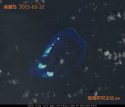......
There is no special rule in international law that specifically prohibits any state from undertaking reclamation at sea; as with any other maritime activity, its legitimacy must principally be reckoned from its location vis-à-vis adjacent land territory. While it is undoubtedly within a state’s sovereignty to reclaim land within the 12 nautical mile territorial sea, beyond that, it must be considered whether it falls within the relevant rights and jurisdictions of states expressly recognized in UNCLOS. From 12 to 200 nautical miles, insofar as reclamation is part of the establishment and use of artificial islands, installations, and structures (stationary oil rigs may be considered as artificial islands), it is governed by UNCLOS articles on the
and
.
Within these areas, coastal states may undertake reclamation as long as they give due notice and give due regard to the rights of all other States (UNCLOS Art. 60.3, 56.2, and 56.3). Such artificial islands, however, are clearly not entitled to maritime zones other than a 500 meter safety zone (Art. 60.5 and 60.8), and they cannot be established where they may interfere with international navigation (Art. 60.7). In the high seas beyond 200 nautical miles, all states have the freedom to establish artificial islands, installations and structures, and may not be expressly restricted by UNCLOS from reclamation activities in this respect.
To a large extent, China takes advantage of loopholes in the Philippines’ legal position. This is on account of the latter’s implicit assumption that all islands are individually entitled to only 12 nautical mile territorial seas, leaving only Palawan’s 200 nautical mile EEZ and continental shelf to reckon with in determining legal rights over Chinese-occupied features. It also exploits Manila’s concession that
at least to 12 nautical mile territorial sea zones.
Figure 1. China’s occupied features in the Spratly Islands region, including Itu Aba under Taiwan’s control, in relation to the Philippine island of Palawan.
Based on these premises, Cuarteron,
, and Gaven Reefs are located in the high seas outside the Philippine 200 nautical mile zone (in the absence of an extended continental shelf claim), making it difficult to assert that any exclusive rights are adversely affected. Johnson South and Kennan Reefs are within 200 nautical miles, but possibly located within 12 nautical miles of adjacent islands or rocks under Vietnamese possession; the determination of their legality will require at least prior detailed surveys and delimitation of maritime zones with Vietnam. Only
stands alone far enough away from any other features above water and well within 200 nautical miles from Palawan, such that reclamation thereon could be subject to a proper legal determination. However, this may require a separate case altogether, since the reported reclamation began after the pending case was initiated.
Apart from the limitations of the Philippine case as formulated, China is also relying on its trump card in the dispute: the status and potential maritime zones of Itu Aba, held by Taiwan. If Itu Aba were to generate a full 200 nautical mile EEZ (unlikely though it may be), the median line between it and Palawan would encompass all of the Chinese-occupied features including Mischief Reef. This clearly requires maritime delimitation which is outside the scope of the arbitration case.
.....


